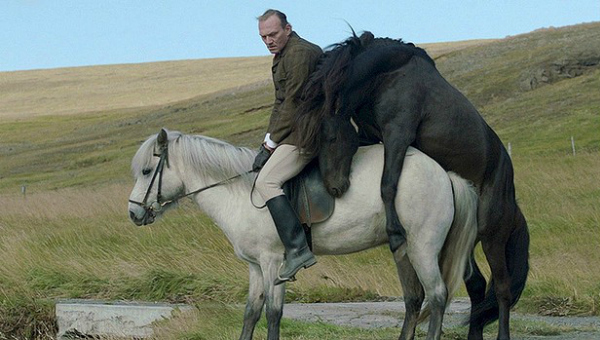 ʻAll the worldʼs a stageʼ perfectly describes OF HORSES AND MEN: aspects of life, sex and death are played out in full view in rural Iceland.
ʻAll the worldʼs a stageʼ perfectly describes OF HORSES AND MEN: aspects of life, sex and death are played out in full view in rural Iceland.
OF HORSES AND MEN is the accomplished directorial debut of established Icelandic actor Benedikt Erlingsson. Itʼs full of lust and sex (human and animal, but thankfully not combined) and the darkest humour. Set in a valley in rural Iceland, the story unfolds in seven chapters, each of which has significant consequences (some appalling) for the residents. The heat of animal passion is the ideal foil for the chilly landscape and the chapters work well together to reach the neat finale.
The valley is sparsely populated with a few horse breeders and their numerous horses, who generally seem much wiser than the humans, especially the men; however, the women are generally strong and smart. The filmʼs themes are Shakespearean in scope – lust, greed, jealousy and the inevitable cost to the perpetrator. Grief, humiliation, strength and compassion exist alongside but throughout, the scriptʼs wicked humour keeps the filmʼs tone bright.
OF HORSES AND MEN opens with an extreme close up of a horseʼs white coat; the camera is so close it almost strokes the neck and flank, itʼs very tactile. Eventually the lens settles on the horseʼs eye, which reflects the opening of the scene that is about to develop. This motif flows through the film, prefacing the new chapter. Thereʼs a strongly sensuous streak throughout as couples (human and animal) eye each other, lick lips, flick tails and hair, make contact.
There is real horse sex – and itʼs definitely not CGI.
The first (and last) chapter focuses on the courtship of a couple who circle around each other in the full glare of their neighbours – all of whom wield binoculars to spy on each otherʼs triumphs and disasters. One afternoon, Kolbeinn (Ingvar Eggert Sigurðsson) rides out on his prized white mare towards the home of Solveig (Charlotte Bøving). With the sun glinting off the neighboursʼ spyglasses, the audience immediately understands that nothing here is private; despite the distances between houses, everyone knows whatʼs going on.
We know little of Kolbeinnʼs or Solveigʼs pasts: whether he has been married before, if she is widowed or divorced; all we know is that he lives alone and she and her young son live with her mother. On the exposed road between their homes, Kolbeinnʼs horse adopts a high-stepping gait that appears ridiculous, but the director explained in a radio interview that it was the most extreme of five types of trotting gait and this fifth gait signifies masculinity in Icelandic culture. Itʼs a courtship display by Kolbeinn in his quest to woo Solveig. Consequently his public humiliation as he rides away from her house (not to be revealed here), in full view of the neighbours, is all the more devastating. Itʼs laugh-out-loud funny, but shocking and ridiculous too.
Further chapters explore the consequences of greed (death by vodka), stubbornness (when a dispute spirals out of control) and condescension (never underestimate a woman); men die, almost go mad or are horribly maimed. Animals perish. There is real horse sex – and itʼs definitely not CGI. There are few reminders of the 21st century in this film – no mobiles, no PCs, nor social media. Although itʼs set in the here and now, itʼs a story that spans the centuries from our earliest interactions with animals and nature. And there is some very fine hand-knitting on display! OF HORSES AND MEN is remarkably unsentimental, which is a relief given the potential pitfalls of using motifs such as the horse and its all-seeing, wise eye. Instead itʼs a thoughtful and bleakly funny exploration of the human condition and itʼs well worth catching.
httpvh://www.youtube.com/watch?v=MKodaUmsYxk


One thought on “Of Horses And Men”
Comments are closed.